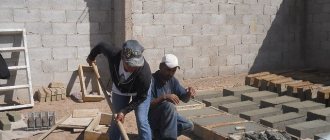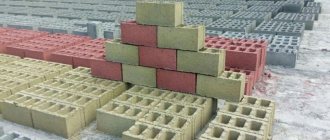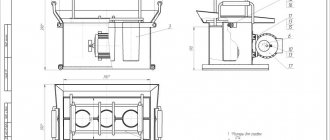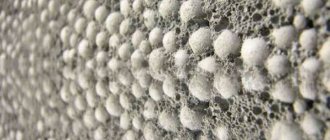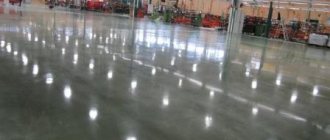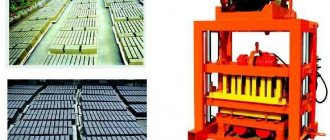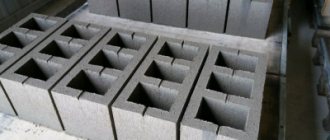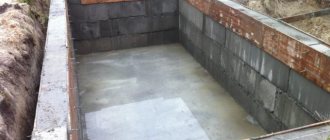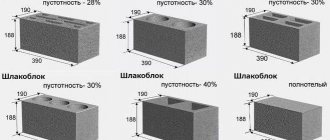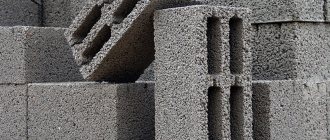A cinder block is a building product that is manufactured industrially or by handicraft. The production uses the method of vibration pressing of concrete in special forms.
Cinder block is one of the most popular building materials due to its low cost composition and low manufacturing cost.
What makes the product popular is the abundance of materials in the working solution—what the cinder block is made of.
Types of building blocks
Brick is still the main material in the construction of high-rise buildings, but for low-rise construction it is cheaper to use other building materials. If you exclude wood, which is now expensive, the choice will still be varied. Modern wall materials are made from:
- foam concrete;
- slag concrete;
- aerated concrete;
- expanded clay concrete.
Block characteristics comparison table
As a filler for cinder blocks, a variety of and sometimes exotic materials are used, which are industrial waste: screenings, broken glass and bricks, sawdust, wood chips.
Let's first consider how expanded clay blocks and cinder blocks are made independently, as the most budget-friendly among all the above building materials.
Expert opinion: Machine for the production of cinder blocks
If you do not have the necessary knowledge and skills to manufacture a machine yourself, we recommend renting equipment. If you want to make your own machine for the production of building blocks, use only high-quality materials. We advise you to pay great attention to the stage of creating a design drawing and calculate all the nuances in advance. Take factory equipment or ready-made equipment of friends and acquaintances as a sample.
Dmitry Orlov
Forms for filling blocks
To create a finished block, special molds are used into which the finished solution is poured. The molds are made of wooden material; rectangles are placed in the inside to create voids of the required size. You can attach plastic film to the inside of the mold, then the blocks will be easy to pull out and their surface will become smooth. The blocks are placed in an open space, and hardening is carried out at air temperature, without the use of additional heating. It will take almost a month to be completely ready, so you need to be patient.
Types and parameters of blocks
Depending on the presence of cavities, materials are differentiated by type:
- Hollow type, providing thermal insulation of buildings and protection from extraneous sounds. They are in demand when constructing permanent walls and are easily combined with other finishing materials. The weight of the products ranges from 8 to 40 kg.
- Solid construction for increased durability. It is used in the construction of foundations; its characteristics correspond to the parameters of silicate products. Weight – from 100 to 2000 kg.
Table of sizes and types of sand blocks
The dimensions of the products affect the scope of application in construction. The standards provide the following size ranges for the production of blocks:
- length 190 – 500 mm;
- width 90 – 500 mm;
- height 185 – 300 mm.
Characteristics of hollowness and dimensions of sand block (cinder block)
The following product sizes are available:
- length 880, 1180, 2380 mm;
- width 300, 400, 500, 600 mm;
- height 280, 580 mm.
According to their purpose, sand blocks are divided into the following types:
- wall, with increased width, used in the construction of walls in one or 2 rows;
- partition walls, have increased moisture resistance. They are used for the construction of interior walls and partitions;
- facing, which do not depend on temperature changes, exposure to moisture, or negative natural factors. Used for finishing external wall surfaces.
Types of sand blocks
Fillers are used to fill the cavities of sand blocks. These are small crushed stone, expanded clay, slag, materials with the addition of sawdust and wood shavings.
Type of filling material
The composition of the cinder block mixture varies according to the type of filling material, and is conventionally designated by various abbreviations.
- A mixture whose binding element is cement. (SCC)
- A solution where the binder is lime. (SKI)
- Addition of slag from various productions. (SKS)
- Using alabaster or plaster. (SKG)
The blocks are divided by size and marked in different ways, that is, number 1 means longitudinal view, 2 means half cinder block, 3 means partition wall type of material. When using a fastening component, it is better not to save money because blocks made with low grades of cement are not able to withstand significant loads and are weak to the effects of precipitation. Due to the influence of such factors, the edges of the block will peel off. Mixtures can be prepared in several ways.
Do-it-yourself cinder block production
If there are no problems with expanded clay in your region, you can consider yourself lucky: expanded clay concrete, despite its cheapness, is rarely found on sale, but this building material is characterized by a whole range of positive properties. To make expanded clay blocks you will need:
- expanded clay itself;
- cement;
- sand;
- water.
The main material for creating the mixture will be fine expanded clay
When mixing the solution, it is important to adhere to a certain sequence: expanded clay is added to the water, then cement, and finally sand. The proportions of the solution are as follows: for nine liters of water, use 54 kg of expanded clay, 9 kg of cement and 27 kg of sand. The result will be a mixture weighing about 100 kilograms, with the yield of finished blocks in the amount of 9-10 pieces.
Cinder block as a building material
Cinder block is a building material that contains slag, concrete mixture, cement, and other additives. The material is shaped like brick. Even inexperienced builders can make cinder blocks on their own.
If the volumes of cinder blocks produced are large, it is recommended to make a special machine, which is placed directly at the construction site. If you follow the steps for preparing the building material, and also strictly follow the recipe, you get a high-quality cinder block.
How are cement-sand blocks produced?
Where would you prefer to live: in a private house or apartment?
This composition of ingredients allows material manufacturers to not only save financial resources due to the low cost of raw materials, but also provide improved performance characteristics. The popularity of sand blocks has increased among customers, as it is a competitive raw material used in the construction of structures.
Manufacturing involves the technology of semi-dry vibrocompression on equipment with increased productivity. The production stages are as follows:
- Mixing raw materials components.
- Filling into steel molds.
- Compacting the fraction until homogeneous.
- Drying products under infrared rays.
- Keep in a ventilated room at room temperature for 4 weeks.
Expert opinion: Sand block walls
Sand concrete blocks are considered durable and reliable and are often used to build foundations. They have good sound insulation and are completely environmentally friendly. Keep in mind that when building a house from sand concrete, you will need to spend money on additional insulation of the walls, but the price of such blocks is low, which is why they are often used in private construction. The heavy weight of sand concrete allows them to be used only in conjunction with the most stable foundations.
Dmitry Orlov
Main characteristics
As I mentioned briefly above, cinder blocks are based on concrete. Various impurities are added to it, after which pressing is carried out. As a result, we get very light blocks with fairly large dimensions and clear, even edges.
Building from such material is a pleasure. Light weight and large size simplify and speed up the laying process as much as possible. Even without hiring a specialized team, you can build a residential building in just a couple of days.
Like bricks, cinder blocks are made in two versions: solid and hollow. The first option is solid, there are few voids in its structure, due to which it is quite durable. The hollow version has three large holes in its structure, which play two roles at once.
Firstly, due to their presence, the weight of the block becomes extremely small. This significantly reduces the load on the foundation and makes the work of building walls even easier. Secondly, these holes can be filled with heat-insulating material, thus creating walls that perfectly retain heat.
However, everything is fine with the thermal conductivity of cinder blocks, as well as with the sound insulation characteristics. Heat is retained well, sound vibrations are well damped, so a house made from such material is very comfortable to live in.
Of course, all these qualities are possible only if the manufacturing technology of the building material has not been violated. Let's move on to the practical part to find out how the production process works and what is needed for it.
Manufacturing technology of expanded clay concrete blocks
A concrete mixer, a standard piece of equipment in a builder’s arsenal, will help reduce time losses and reduce labor costs. If there is a shortage of time, the problem can be solved by using a vibrating machine; a simple model of such a machine can be made independently.
A modern cinder block has dimensions of 188x190x390 mm, a solid building material is characterized by sufficient strength for arranging foundations and multi-story construction, hollow ones are used in all other cases. The voids can be round, rectangular or square, the number varies from one to 8-10 voids, the voidness rate ranges from 25-50%. Almost equal in strength to monolithic products, hollow cinder blocks allow you to save expensive cement by almost half.
For quick and high-quality mixing of the mixture, it is advisable to use a construction concrete mixer
The following can be used as filler in production:
- coal slag;
- fine gravel;
- crushed stone screening;
- sand;
- brick waste;
- broken glass;
- ash;
- perlite;
- gypsum;
- sawdust;
- wood chips.
When mixing the solution, the proportions will depend on the composition of the filler. The main condition is that the finished solution does not spread. Cement in the production of slag concrete is used at a grade no lower than M400; to improve the performance properties of the finished product, plasticizers can be added to the solution.
Portable machine for making cinder blocks with your own hands
A guideline for self-production of a solution for cinder blocks can be the factory recipe: for seven parts of blast furnace slag - two parts of coarse sand, one and a half parts of cement and up to three parts of water. The way to check that the consistency of the solution meets the requirements is simple: throw a handful on the ground, it should crumble. If you collect the solution and squeeze it in your fist, it should return to the shape of a ball.
Instructions for creating homemade containers
Containers for homemade molds can be of different sizes, both standard and non-standard. It all depends on the wishes of the owner and his preferences.
Please note : the larger the blocks, the less mortar will be needed to lay them and the fewer cold bridges there will be through the seams between the products.
Large blocks in size are convenient and practical, but it is better not to make forms over 2 m in length or width , because such formwork will be bulky and difficult to transport and lift. It is better to make several formworks, but smaller ones.
To make your own mold, you need to:
- First, decide on the dimensions of the future workpiece, and then cut out the building material according to these dimensions (4 walls, bottom and, if necessary, partitions).
- Set the height of the elements and cut the walls to this height.
- The walls of the formwork must be mounted in such a way that the transverse parts are inserted into the longitudinal ones and thereby form cells of the same size.
- Form the bottom from building material or line it with cellophane instead of the bottom.
- If you need to make hollow cinder blocks, then you will also need void formers for these purposes. They can be wine or champagne bottles filled with water. Bottles can replace pipes with a diameter of about 6 cm or rectangular wooden blocks.
- Insert void formers into the container and secure them. The number of voids in the finished product should not exceed 40% of the total mass of the block.
- Pour the solution and wait a day so that the material can be removed from the mold and transferred to the place for subsequent drying.
Advantages
A distinctive feature of the blocks is their increased level of sound insulation. They protect people in the building from the negative effects of external factors. The products meet the requirements for construction raw materials and are combined with other materials, including insulation materials. They are durable, reliable, tough. Let's take a closer look at the positive aspects:
- application for external and internal construction activities;
- increased strength, allowing for the construction of foundations;
- high coefficient of sound insulation provided by cavities;
- low weight of hollow blocks;
- long service life. The material is not subject to rotting, retains performance characteristics at high humidity, and is not susceptible to temperature changes;
- high resistance to elevated temperatures;
- environmental friendliness, which is based on the use of safe raw materials;
- low price is a plus that customers appreciate;
- savings during construction due to the fact that the dimensions allow using one sand block instead of three bricks. The result is the use of less mortar and bricks. The construction of buildings from sand blocks reduces costs by 40% compared to brickwork;
- reduction of construction time;
- simplicity of masonry, allowing you to build a building yourself without hiring hired builders.
Having these advantages, this material has a number of minor disadvantages.
Composition and sizes of cinder blocks
The dimensions of cinder blocks are determined by the standard. For this material they are 380x180x187 mm (length/width/height). But it is not necessary to adhere to these standards, because in individual construction there is a need to combine materials. The parameters of cinder blocks are not strict values, therefore they can be changed taking into account the individual characteristics of the building and the direction of construction.
Please note that cinder blocks with standard parameters are difficult to use in practice. The reason for this is the considerable specific gravity of the material, varying from 18 to 26.5 kg. Because of this, the progress of building construction is slowing down.
[my_custom_ad_shortcode3]
Preparation of cinder blocks without special equipment
If you have free time and are unable to make a simple vibrating machine for the production of slag concrete, it is advisable to use a mold with boards or sheet metal as the walls and bottom. It is preferable to use one matrix for the manufacture of several blocks of slag concrete, at least in order to save materials. To create voids in the mold for pouring the solution, you can use bottles, scraps of metal pipes, wooden cylinders or bars.
Manual machine for making cinder blocks and expanded clay blocks at home
The procedure itself is simple: prepare the solution, pour cinder concrete into the molds, level it, removing excess. After a day, the blocks can be carefully removed and laid out to dry on a horizontal surface. To protect the finished material from cracking and getting wet during drying, cover the cinder concrete stacks with plastic film.
Technological process of casting cinder blocks
Good and reliable cinder blocks are obtained by using a solution of medium fluidity. This factor is important to consider during the preputial distribution of components and their mixing. Often this is a typical concrete solution, mixed in a concrete mixer or manually with the addition of plasticizers and production waste.
After preparing the mixture, according to the proportion of the solution for making cinder blocks, it is poured into molds and wait until the blocks harden. This is a home option for casting building blocks from slag. In production conditions, everything happens differently. Specialized equipment is used here, and special techniques for mixing components are used.
Knowing how to determine the proportions for preparing a solution for a cinder block, you can make the building material yourself. How to do it: with your own hands or purchase factory units, it’s up to you to decide. In any case, following the selection rules and expert advice, typical mistakes when purchasing building materials can be easily avoided. When giving preference to purchased cinder blocks, choose materials from proven rating companies.
Knowledge of the proportions and standards for the production of concrete solutions will help to produce a product that meets technical standards and is suitable for the construction of residential buildings.
For the construction of low-rise buildings, cinder blocks are often used - wall stones obtained by pressing concrete mortar into a mold. They have a number of advantages, including soundproofing, good thermal insulation and low cost. Previously, they were produced only at the factory, using special equipment and a steaming chamber, but now you can do the production yourself, for this it is enough to know the proportions of the solution for the cinder block and have a vibration installation.
Table of contents:
- Preparatory work
- Manufacturing
Cinder blocks are suitable for the construction of industrial buildings, sheds, garages, basements, workshops, service stations; they are also used for laying foundations, building interior partitions, laying ventilation ducts, and insulating walls.
Proportions of solution for cinder blocks For production, 3 components are used: a binder, sand and filler - slag. Clay, gypsum, lime or cement can act as a binder. Much attention is paid to the purity of the filler - it should be free of foreign impurities such as coal, ash or earth. Composition of the solution for cinder blocks: cement-sand-slag in a ratio of 1:3:5. When preparing the mixture, it is necessary to add a small amount of water, approximately 0.5% of the total volume of cement. You can make cinder blocks without using sand, then the proportions will be 1:9, the water consumption will remain the same.
[my_custom_ad_shortcode2]
Making cinder blocks on a machine
Adding a slag concrete vibrator to the above-described production scheme provides the opportunity to significantly improve the quality of products and at the same time speed up the process.
It is not difficult to assemble such a machine; if you follow all the recommendations, this equipment will work no worse than its factory counterparts. The simplest version of a vibrocompression machine involves the use of a homemade matrix, a vibrator and a hand press. To reduce physical stress, the manual press can be improved by using a lever system.
Drawing of a homemade machine with a vibration motor for making cinder blocks and expanded clay blocks
A set of tools and materials necessary for the manufacture of a vibration machine with a metal mold:
- welding machine;
- Bulgarian,
- a set of keys;
- vice;
- sheet metal with a thickness of at least 3 mm;
- pipes for creating voids with a diameter of 8-10 mm;
- channels, strips of metal;
- low-power electric motor (up to 1 kW);
- connecting elements (bolts, nuts, cotter pins).
The sequence of actions when making a homemade vibrating machine:
- Using a grinder, we cut out the walls of the matrix from sheet material. If the mold is intended for the manufacture of several block products, we provide for the presence of the corresponding number of partitions in the matrix.
- We cut off the required number of blanks from the pipe (at the rate of 3 pieces per brick), the height of which should be 3-5 mm less than the height of the matrix. The taper of the pipes is achieved using the following technique: cut the pipe in half and crimp the workpiece in a vice (for thick-walled pipes you can use a lathe).
Drawing for the manufacture of a machine with lightweight extrusion of building blocks
- Each pipe section is welded tightly on both sides.
- We weld the plates to the pipes, connecting them together. For fastening to walls, it is better to provide a removable connection, which will allow, if necessary, to remove the limiters for the production of monolithic cinder blocks.
- Using welding, we attach bolts for attaching the electric motor to the long outer wall.
- We weld a metal apron on top of the form.
- We make a press in the form of a thick-walled plate, provide for the presence of holes with a diameter slightly larger than the smaller diameter of the limiter pipes (so that the press enters the matrix at a distance of no more than 50 mm).
- We weld the handles to the press.
- We install the motor. We weld an eccentric onto the electric motor shaft (ordinary bolts are suitable as material for the eccentric; they are welded parallel to the shaft and leave room for screwing on the nuts, which will allow you to adjust the amplitude of vibrations).
- We thoroughly clean the device, polish the surfaces, and paint the homemade unit for the blocks.
Photos of the structure from different angles
The machine allows you to significantly increase work productivity. The equipment has a fairly simple design.
Vibrating machine
Assembling the machine
The main element of a homemade vibratory compacting machine is a mold (matrix) for slag concrete mortar. By its design, this form is a metal box with internal elements in the form of voids. The void stoppers can also be removable.
Compact cinder block machine
The work kit includes the following materials and tools:
- welding machine;
- standard set of locksmith tools;
- grinder;
- vice;
- sheet steel 3mm thick. It will take about 1 m2;
- a pipe with a diameter of 7.5-9 cm. Approximately 1 m of pipe is needed;
- metal strip 3 mm thick. You will need about 30 cm of material;
- electric motor with a power of 0.5-0.75 kW;
- nuts;
- bolts.
Compact cinder block machine
Side view
Front view
Front view
First step. We make a mold according to the size of the future blocks. We cut out the side faces of the matrix from sheet steel. We will make a form for 2 blocks at once. To do this, we cut out the inner central partition from steel and fix it in the box.
Second step. We determine the height of the elements to decorate the voids.
Third step. We cut 6 pieces of pipe along the length of the limiting cylinders to form voids.
Fourth step. We give the pipes a conical shape. To do this, we cut each piece of pipe longitudinally to the middle, compress it with a vice and connect it using a welding machine. We brew each cone on both edges.
Fifth step. We connect the stops in a row along the long edge of the cinder block. Along the edges of the row we add a 3-centimeter thick plate with holes for fastening with eyes.
Sixth step. We make a cut in the middle of each such compartment. We weld lugs on the back side of the form. They will allow temporary fastening of elements to create voids. A very convenient solution - it will be possible to remove the cylinders and make monolithic blocks.
Compact cinder block machine (press on top)
Seventh step. On the outside of one of the transverse walls we weld 4 bolts for the mounting holes of the vibration motor.
Eighth step. Using welding, we attach an apron on the loading side and blades along the edges.
Ninth step. We prepare all structural elements for painting - we clean them and thoroughly polish them.
Tenth step. We do the press. It will look like a plate with holes repeating the location of the holes in the block.
We make the plate of this size and fix it in such a way that it can go deep into the box at the place where the limiters are installed by 5-7 cm.
Finally, all that remains is to weld the handles to the press, coat the structure with a primer mixture and mount the vibration motor.
An ordinary electric motor can be converted into a suitable vibration motor. To do this, it is necessary to weld eccentrics onto the engine shafts. We won’t bother too much - we’ll just weld the bolts so that their axes coincide. To regulate the frequency and strength of vibration, screw nuts onto the welded bolts.
Vibrating device
Machine for cinder blocks
Manufacturing process
I have already described the process briefly above: mix, shape, press. The only difficulty - and even then, not critical - lies in the manufacture of forms. There are two options for how to make these structures with your own hands: a box made of wooden boards or a machine with a built-in vibration device. Let's take a closer look.
Wood forms
This is the simplest option. The wooden form is a banal box. You can make separate ones for each element, but the optimal solution is to create one large form, divided into cells using inserts.
Drawings for such a product are not mandatory; there is nothing complicated there. The most important thing is to maintain the correct dimensions. When making a large frame, keep in mind that some of the internal volume will be taken up by the thickness of the partitions, so calculate the dimensions in accordance with this factor.
The form can be made entirely of wood. But many craftsmen claim that it is much more convenient to build a wooden frame and make partitions from thin metal sheets. There are also a couple of nuances that need to be taken into account:
- there is no need to do the bottom. The mold is placed on any flat surface - table, floor, etc. - covered with polyethylene, and after that the mixture is poured into it,
- The partitions inside the frame should be made removable, fastening them together using specially made cuts. An external frame will support this entire structure along the perimeter. This approach will make removing finished blocks simple and convenient,
- The wooden parts of the structure should be coated with oil paint, this will prevent the mixture from sticking to the walls. Naturally, the coating must be completely dry before use.
- hollow blocks are made using exactly the same mold, but in the cells already filled with solution, glass bottles should be placed upside down, three for each block. The excess mixture that rises must be removed. The bottles are removed five to six hours after the drying process begins, and then the blocks are left for another 24 hours before they can be removed from the cells.
Composition of expanded clay concrete
Sand from crushing screenings is best suited for expanded clay concrete, and indeed for any building mortars
You should not use high grade cement for blocks, M 400 is enough
Expanded clay concrete is almost no different from the composition of heavy concrete; it includes:
- cement;
- fine aggregate - sand;
- coarse aggregate - expanded clay, we will talk about it below;
- additives that modify the properties of the mixture and material (optional).
The components also include water, which is necessary for preparation and hardening. We'll talk about the selection of the lineup a little later. Additionally, to increase the strength of the blocks, microfiber (polymer, glass, basalt, etc.) can be introduced into the mixture, which will reinforce the stone.
The requirements for the components are the same as for conventional concrete: quality, absence of foreign impurities. It is advisable to use washed sand.
Where can you make cinder blocks?
To make blocks, it is necessary to prepare a special platform. This can be a large room with a flat floor, ventilation, and heating as needed. Under such conditions, cinder block can be produced all year round. You can use an open asphalt, concrete or earthen area, the main condition is that it is level. If the open area is not too level, then pallets must be installed and blocks laid out on them. If the proportions are observed correctly, you can obtain high-quality and durable building material.
